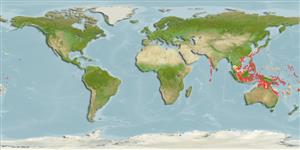Environment: milieu / climate zone / depth range / distribution range
Écologie
marin récifal; profondeur 8 - 50 m (Ref. 37816). Tropical; 25°N - 35°S, 115°E - 170°W (Ref. 57231)
Indo-West Pacific: Maldives (Ref. 30829); southern Japan to Indonesia and northern Australia, eastward to Samoa and Tonga.
Taille / Poids / Âge
Maturity: Lm ? range ? - ? cm
Max length : 30.0 cm TL mâle / non sexé; (Ref. 54980)
Description synthétique
Clés d'identification | Morphologie | Morphométrie
Épines dorsales (Total) : 11; Rayons mous dorsaux (Total) : 13 - 14; Épines anales: 3; Rayons mous anaux: 8. This species is distinguished by the following characters: body moderately deep; greatest depth 2.4-2.6 in SL; preopercular notch and knob well developed; vomerine tooth patch crescentic, without medial posterior extension; gill rakers of first gill arch 6-7 + 13-15 = 20-23; caudal fin emarginate; scale rows on back rising obliquely above lateral line. Colour generally grey to pinksh, silvery ventrally; a series of 10-12 faint yellow stripes on side; some specimens with a black spot, eye size or smaller, below anterior part of soft dorsal fin at level of lateral line; spinous dorsal fin whitish with a yellow margin; median fins yellowish, although pelvic fins sometimes white; axil of pectoral fins brown on dorsal portion (Ref. 9821, 90102).
Swim well above the surface of the reef in aggregations, consisting of several hundred individuals (Ref. 11902, 48635). Feeds on fishes, shrimps, crabs, other crustaceans, cephalopods, and some planktonic items. Caught mainly with handlines and bottom longlines, and marketed fresh (Ref. 9821).
Life cycle and mating behavior
Maturities | Reproduction | Spawnings | Egg(s) | Fecundities | Larves
Allen, G.R., 1995. Lutjanus rufolineatus, a valid species of snapper (Pisces, Lutjanidae) with notes on a closely allied species, Lutjanus boutton. Rev. Fr. Aquariol. 22(1-2):11-13. (Ref. 11902)
Statut dans la liste rouge de l'IUCN (Ref. 130435)
Menace pour l'homme
Harmless
Utilisations par l'homme
Outils
Articles particuliers
Télécharger en XML
Sources Internet
Estimates based on models
Preferred temperature (Ref.
123201): 25.3 - 28.8, mean 27.7 °C (based on 214 cells).
Phylogenetic diversity index (Ref.
82804): PD
50 = 0.5000 [Uniqueness, from 0.5 = low to 2.0 = high].
Bayesian length-weight: a=0.01995 (0.01220 - 0.03263), b=3.00 (2.87 - 3.13), in cm total length, based on LWR estimates for this species & Genus-body shape (Ref.
93245).
Niveau trophique (Ref.
69278): 3.8 ±0.7 se; based on size and trophs of closest relatives
Résilience (Ref.
120179): Milieu, temps minimum de doublement de population : 1,4 à 4,4 années (Preliminary K or Fecundity.).
Fishing Vulnerability (Ref.
59153): Low vulnerability (20 of 100).
Nutrients (Ref.
124155): Calcium = 47.5 [31.3, 66.3] mg/100g; Iron = 0.377 [0.239, 0.568] mg/100g; Protein = 18.5 [17.0, 19.9] %; Omega3 = 0.144 [0.101, 0.200] g/100g; Selenium = 52.4 [35.0, 76.6] μg/100g; VitaminA = 172 [32, 639] μg/100g; Zinc = 0.493 [0.392, 0.688] mg/100g (wet weight);
